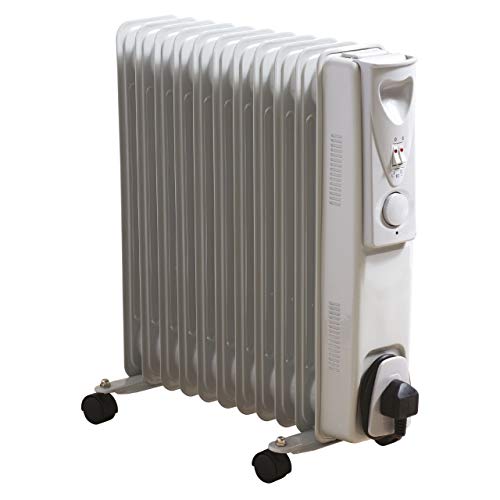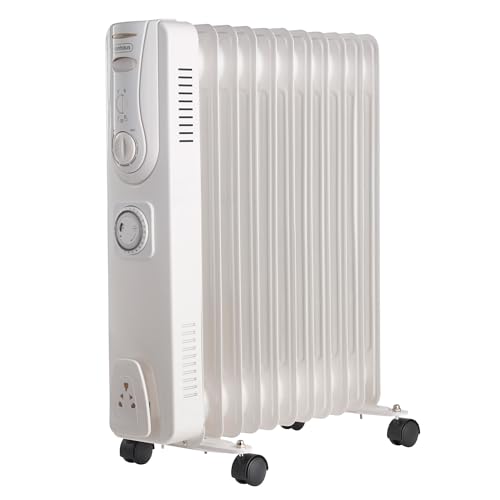Why Choose a Small Oil Radiator?
Filled with thermal fluid and adorned with a heating element oil radiators create lasting warmth through convection and radiation. They’re also able to be carried around which allows you to heat the space you’re using and avoid wasting energy in empty areas.
They use very little electricity and require very little maintenance – all you need is a little wiping down with a damp, clean cloth. They can be set on their backs and perform effectively.
Safety
Like the name suggests, oil radiators are a form of portable heater that uses an internal reservoir of engine oil or mineral to heat a room. They resemble traditional radiators but are smaller and less bulky. They are connected to the electricity of your home through an ordinary wall plug and can be moved around easily on their own wheels or with the aid of a carry handle. A majority of these radiators come with an hourly clock that allows you to set start and stop times for heating.
 When you turn on the heater the electrical current flows through a metal resistive wire in the base of the radiator. The friction warms the oil filled radiator with thermostat molecules. As the oil molecules expand, they push any cooler oil towards the element where it is heated. This process continues for as long as the heating element is on.
When you turn on the heater the electrical current flows through a metal resistive wire in the base of the radiator. The friction warms the oil filled radiator with thermostat molecules. As the oil molecules expand, they push any cooler oil towards the element where it is heated. This process continues for as long as the heating element is on.
It is vital to note that these heaters should not be positioned anywhere near a water source, such as a sink or bath. Carbon monoxide is generated by these heaters and could be fatal if inhaled. It is also recommended to keep them out from materials that ignite, such as wallpaper and draperies.
Many people ask whether or not radiators that are filled with oil filled radiator oil are safe and, in the event that they are, how long. The answer is yes; they are more secure than other types of heaters. Unlike gas and electric powered heating systems, which may release carbon monoxide or even burn out if they’re not properly maintained, these radiators use an internal oil reservoir to ensure that the room is heated safely.
Due to this, they don’t contain heating elements that can burn or catch flames, and there’s no need to replenish them until the tank is empty. However, it is essential to use a suitable extension lead and never use one that’s not designed for the load of your heater. This prevents the wires from overheating and causing an accident.
The tip-over switch is an additional safety feature. It will shut down the device if the device is knocked over or tipped. This can help protect against accidental or deliberate mishaps, which could otherwise result in serious injuries.
Energy Efficiency
The energy efficiency of a small oil radiator makes it a cost-effective heating option for those concerned about skyrocketing electricity bills. By keeping heat in the system and using thermostats to maintain an optimal temperature, oil heaters utilize energy efficiently and provide long-lasting warmth, without adding to your utility bill. These radiators use electricity, but they do so in a way that is eco-friendly.
Radiators that are filled with oil are rated to have more than 90 percent energy efficiency. This is due to the fact that they convert every Watt of electricity directly into thermal energy, with minimal loss. This is far more efficient than electric convection radiators that rely on air convection and fans to move heat around the room. This type of radiator makes use of thermostats to keep an even temperature and shut itself off when the room isn’t being used, which can help to reduce the amount of electricity used.
The amount of energy consumed by a heater is based on many factors, like the power of the radiator as well as the size of space it is designed to heat. The more powerful the heater, the faster it warms up and the bigger the area that it can heat. This also means that it will consume more power than a model that has less wattage.
Energy consumption can also be affected by factors like room size and insulation, which could affect the amount of heat required. In a room that is not well-insulated it will require more heat required to feel comfortable. This could result in an increase in the amount of electricity consumed. In addition, certain thermostat settings can result in the heater being turned on and off more frequently than is necessary to maintain the temperature at a comfortable level.
 If you adhere to a few easy energy-saving suggestions, you can reduce the amount of power your radiator consumes. This includes turning off your radiator when you aren’t in the room. You can also change the thermostat to a higher temperature and ensure that all drafts are closed.
If you adhere to a few easy energy-saving suggestions, you can reduce the amount of power your radiator consumes. This includes turning off your radiator when you aren’t in the room. You can also change the thermostat to a higher temperature and ensure that all drafts are closed.
Durability
Oil radiators are fantastic because they retain heat very well. This means that even after you have turned off the power, they will keep a room warm for many hours. This means they don’t consume more energy than is necessary. This is the reason oil radiators tend to be less expensive than fan-powered heaters.
This could also mean that they take longer to reach the maximum temperature, and are slow to warm up overall. It is important to conduct your research and consider all aspects before you make a purchase.
The weight and size of a portable oil heater are other important aspects to take into consideration. A lighter model is ideal if you are looking for something that is easy to move. For people with mobility issues or vision problems, it is also important to consider how simple the heater is to use.
If, for instance, you opt for an item with a control panel digital, then it can be a problem for people who have poor vision or mobility issues to use. On the other hand models that are more traditional, with a simple on/off switch and a dial that is clearly marked with “min” and “max the ideal choice for those who struggle to use complicated electronic devices.
While it is incredibly rare for a tiny oil radiator to leak, the possibility for this happens and must be considered prior to purchasing. Leaks from these heaters could cause serious damage if they are not treated quickly. They can also pose a health risk in the event that they are able to get into your airways.
One way to reduce this is to make sure that the radiator is kept in a upright position always, as this will prevent any potential damage from happening and will also ensure that it is operating correctly. You can also choose one with a vented system that circulates the oil even if it is on its side.
Ease of Maintenance
oil filled electric radiator wall mounted filled radiators are an excellent choice for those looking for an easy-to-use heater that can heat their home in an elegant and efficient way. These heaters are among the most popular models of our online selection and are perfect for heating individual rooms or small spaces in the home. They are also among the cheapest choices in our electric heating review.
Oil-filled radiators are space heaters that are made of mineral oil and have been heated by an electric heating element. This heats the oil so it can keep an area warm for a long time at a time, using less energy than it does to keep the air warm for the duration of. These heaters resemble central heating radiators, but are smaller and lighter. They are therefore more portable. They usually connect to household electricity with an ordinary plug and come with either wheels or carrying handles for ease of movement.
They require minimal maintenance. If they do leak, don’t try to refill them by yourself. The oil inside could be under pressure and create a fire risk. If you’re concerned that your heater could be leaking, contact its manufacturer immediately.
The De’Longhi Nano 500W Filled Radiator heater is by far the most affordable of our round-up to run, but it only produces only a small amount of heat and is therefore not suitable for larger rooms. The more robust models, like the De’Longhi Dragon 4 Oil Filled Radiator or the VonHaus 11 fin 2500W oil-filled radiator, can generate more heat while using the same power and are better suited to most homes.
Be aware of the size of the radiator before buying, especially in cases where mobility or vision issues are an issue. Many of the models we’ve examined have an LCD display on the control panel, which may be difficult to read for those with poor vision. VonHaus and De’Longhi both have large controls with clear markings so they should be easy for anyone with this type of difficulty to operate.
